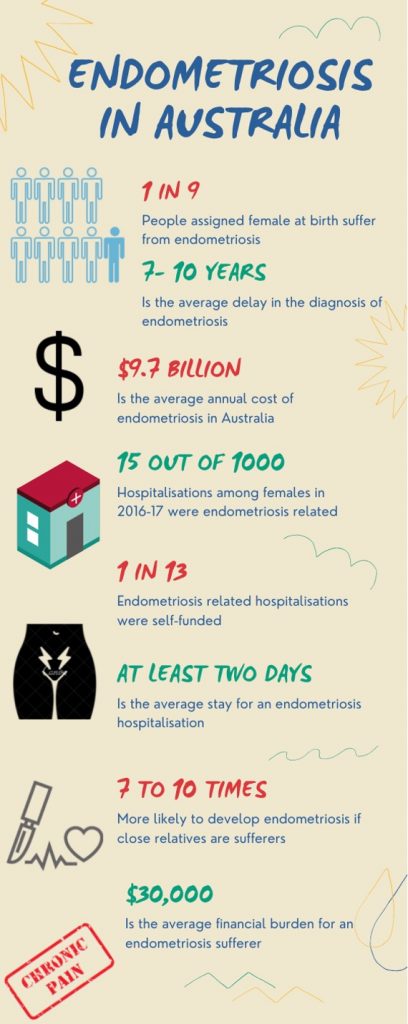This post is over three years old, the information may be outdated.
On no particular Tuesday, I awake to a slight cramping of my lower abdomen. Bloated, I head to the bathroom, hunch over the sink, flailing my body sideways. The pain has become overwhelming.
Instead of breakfast, I am seeking control of my body, hyperventilating with short, sharp inhales. My mind can only question whether it was something I ate last night, or a position I may have slept in. And yet, there is no way of knowing when this attack will end.
This is Endometriosis – a severe and lifelong disease that occurs when cells similar to the lining of the uterus grow in other parts of the body.
More than just my story
With one sufferer for every nine women, Endometriosis is as common as asthma and diabetes.
Symptoms can range from pain during and without a period, pain during and after sex, infertility, bloating and fatigue.
In 2019, the UK National Health Service acknowledged Endometriosis as one of the top 20 most painful health conditions. Health professionals assure hormone suppression and invasive surgery remain our best treatments. Neither of which, are by no means a cure.

A shift in women’s healthcare
The 1960s saw the introduction of the contraceptive pill, bringing less babies and more periods. EndoActive co-founder, Lesley Freedman, said this fostered conversations about the endometriosis related symptoms more and more women were experiencing. This prolonged recognition may well be the reason so little is known about Endometriosis.
Prior to the 2018 National Action Plan, the Australian government allocated less than $1 million to endometriosis research.
The Guardian’s Gabrielle Jackson said “that’s about $10 in funding per person with Endometriosis and $200 per person with diabetes, a disease considered to have a similar quality of life impact and to affect about the same number of women.”
Even with the National Action Plan in place, Tasmanian politician, Michelle O’Byrne, was quick to comment on its disproportionate approach.
“It’s appalling the current research investment is only 0.2% of the annual cost of endometriosis,” she said.
If there is a will, there is a way
Health professionals confirm there is more we don’t know about Endometriosis than what we do know. However, an increased awareness of Endometriosis has been attributed to the rise in social media activity.
This year’s federal budget jumped on board with a $354 million women’s healthcare package. Up to 16% of the package was allocated to Endometriosis and other women’s reproductive health initiatives.
Co-founder of Endometriosis Australia, Donna Ciccia, said she is “very happy that a disease that no one talked about and is often shrouded in taboo is garnering attention and attracting some funding.”
In the last month, the same peak woman’s health body announced that up to $100,000 in funding is available as awarded research grants.
Applications are now open to eligible individuals and organisations who wish to delve into topics directly linked to Endometriosis.
Charles Sturt researchers intending on applying should contact research@csu.edu.au to discuss approval prior to the August 17 closing date.
Play your part
Not a researcher? You too can bring hope to the women who continue to manoeuvre through an almost decade-long diagnostic delay.
Please consider donating to Endometriosis Australia today!
Infographic references:
- B, Hustwaite. (2021). Underground Writers. ‘How to Endo’. Retrieved from https://underground-writers.org/review-how-to-endo-by-bridget-hustwaite-by-ebony-bryant/
- J, Hailes. (2021). Jean Hailes for Women’s Health. Diagnosis. Retrieved from https://www.jeanhailes.org.au/health-a-z/endometriosis/diagnosis
- Endometriosis Australia. (2020). Endometriosis Australia. Endo Facts. Retrieved from https://www.endometriosisaustralia.org/research
- AIHW. (2019). Australia Government: Australian Institute of Health and Welfare. Endometriosis in Australia: prevalence and hospitalisations. Retrieved from https://www.aihw.gov.au/getmedia/a4ba101d-cd6d-4567-a44f-f825047187b8/aihw-phe-247.pdf.aspx?inline=true
- AIHW. (2019). Australia Government: Australian Institute of Health and Welfare. Endometriosis in Australia: prevalence and hospitalisations. Retrieved from https://www.aihw.gov.au/getmedia/a4ba101d-cd6d-4567-a44f-f825047187b8/aihw-phe-247.pdf.aspx?inline=true
- AIHW. (2019). Australia Government: Australian Institute of Health and Welfare. Endometriosis in Australia: prevalence and hospitalisations. Retrieved from https://www.aihw.gov.au/getmedia/a4ba101d-cd6d-4567-a44f-f825047187b8/aihw-phe-247.pdf.aspx?inline=true
- Australian Government: Department of Health. (2018). National Action Plan for Endometriosis. About the Plan. Retrieved from https://www.health.gov.au/sites/default/files/national-action-plan-for-endometriosis.pdf
- Endometriosis Australia. (2020). Endometriosis Australia. Endo Facts. Retrieved from https://www.endometriosisaustralia.org/research










